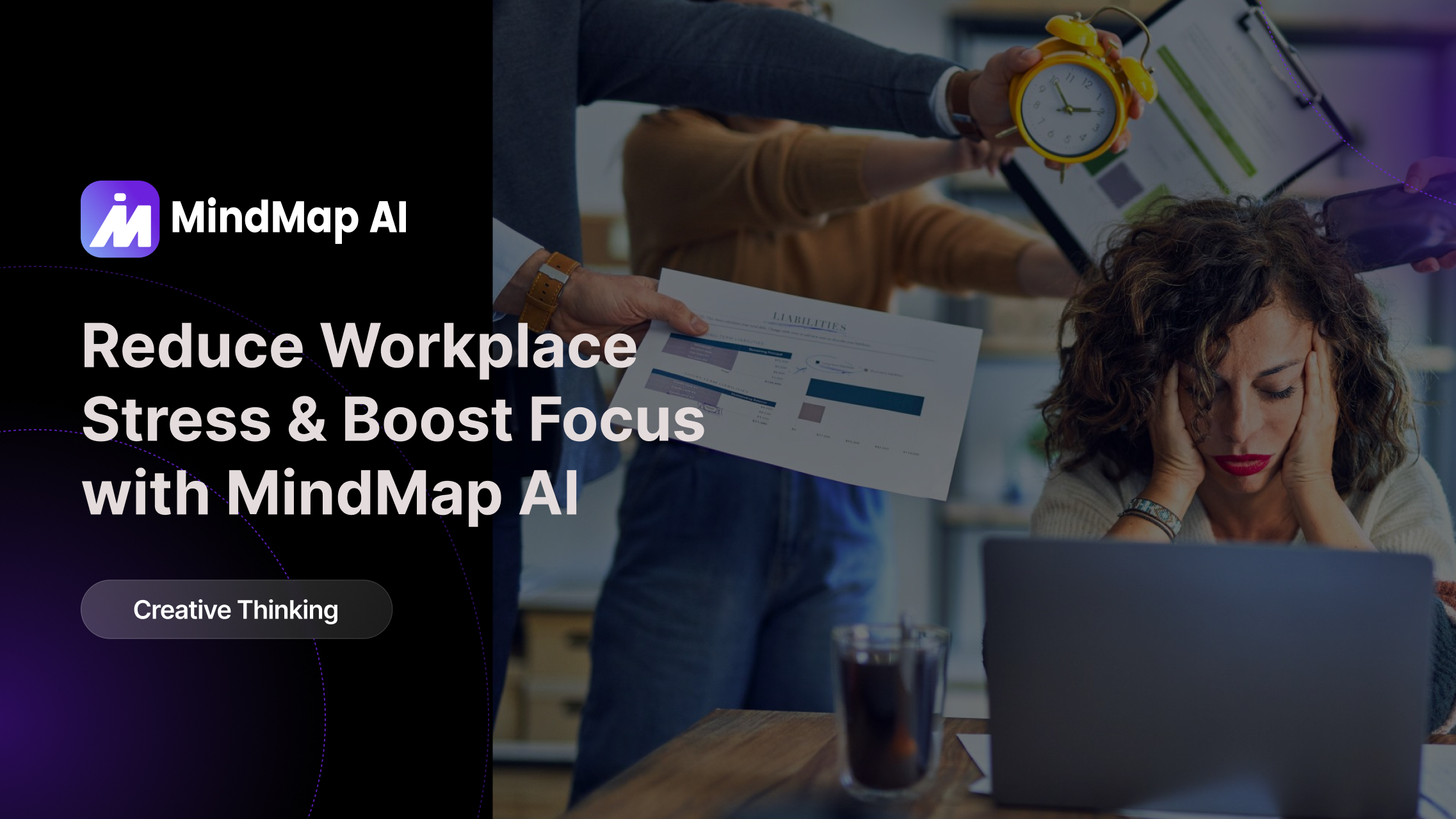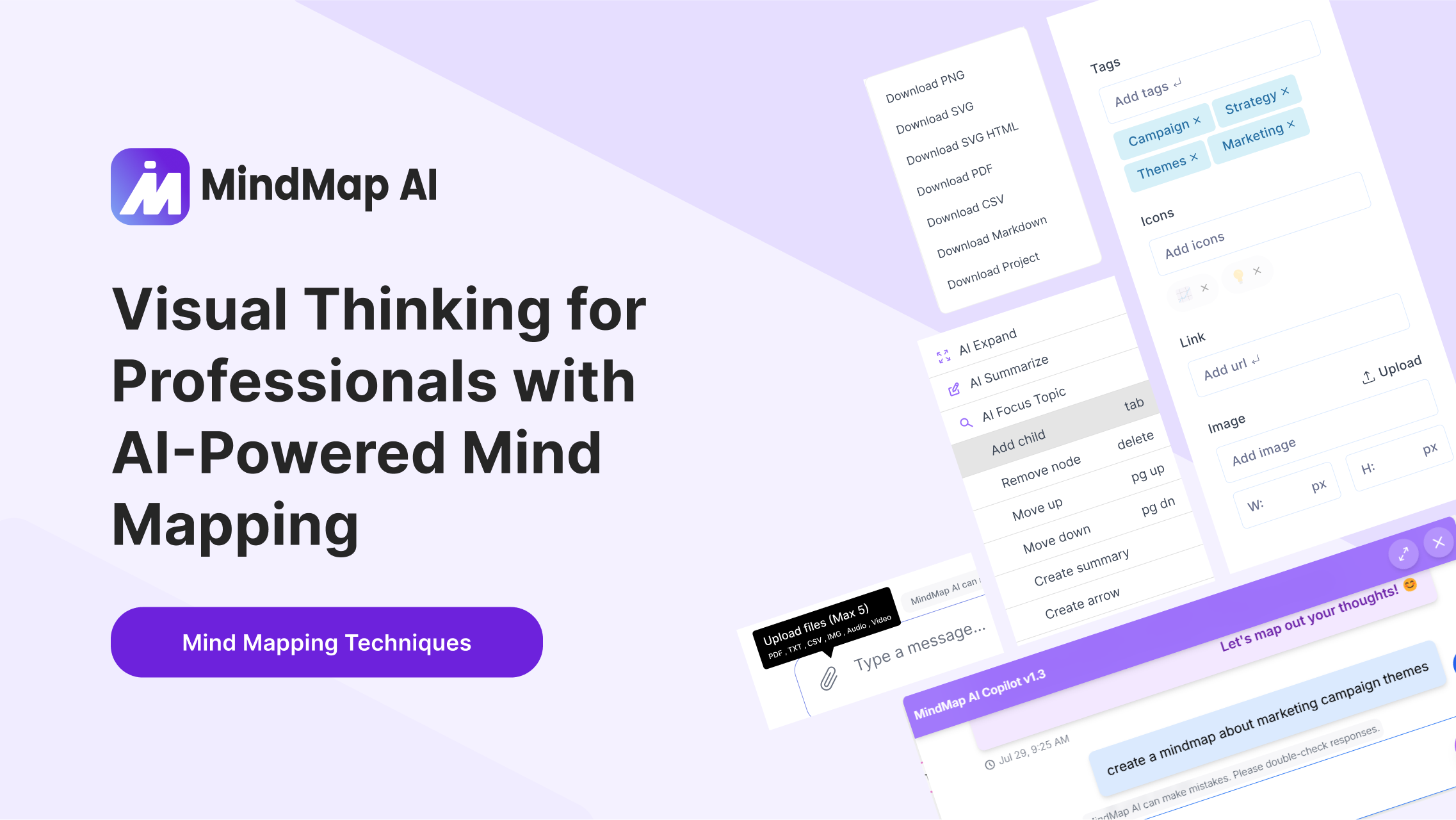
Reduce Workplace Stress & Boost Focus with MindMap AI
Mind mapping isn't just a creative exercise; it's a proven stress reduction method and a powerful way to enhance focus. By turning scattered thoughts into a structured mind map, you free up mental bandwidth and calm your nervous system. In this guide, you'll learn how mind mapping, mind map techniques, and the MindMap AI tool can help you manage workplace stress, reclaim clarity, and supercharge productivity.
What Happens When Stress Takes Over?
When you face a looming deadline or a complex project, your brain perceives a threat and releases cortisol and adrenaline. Those hormones:
Fuel the amygdala (your fight-or-flight centre)
Starve the prefrontal cortex (the seat of planning and sustained attention)

The result is a foggy mind, racing thoughts, and diminished focus on high-priority tasks.
High cortisol → amygdala takeover → underpowered prefrontal cortex → scattered focus.
Ready to off-load that mental clutter in seconds?
How Can Mind Mapping Interrupt This Cycle?
Mind mapping offloads mental clutter into a spatial format your brain can process without stress. By externalizing every task, worry, or half-formed idea into nodes and branches, you immediately:
Free up working memory for high-priority tasks
Visualize priorities without lengthy deliberation
Reduce rumination, replacing it with structure
What Happens in the Brain During a Mind Map Session?
Whole-brain activation – Radial layouts engage both hemispheres: the left (verbal, logical) processes keywords; the right (visual-spatial) decodes colour, shape, and position.
Cognitive off-loading – Externalising thoughts shrinks the items competing in working memory. Lower load → lower stress.
Visual hierarchy – Branch size, colour, and distance from the centre signal importance, giving the brain instant prioritisation cues without lengthy deliberation.
For a hands-on demo, open the Text to Mind Map Generator and paste today's notes to watch your mental load shrink in seconds.
What Does Research Say About Mind Mapping, Stress, and Focus?
Workplace studies confirm mind mapping stress management:
| Finding | Source | Why It Matters |
|---|---|---|
| Workplace “stressor mind maps” lowered perceived stress and freed working memory. | Medium case study | Mental bandwidth reclaimed → sharper focus. |
| Mind mapping boosts meaningful learning by forcing connections between ideas. | Nulab science-backed benefits list | Seeing relationships reduces cognitive load when switching tasks. |
| Acute stress reduces prefrontal cortex activity (responsible for working memory) and shifts resources to survival circuits. | PubMed neuro-imaging study | Understanding this helps explain why reducing stress improves focus and decision-making. |
Putting those findings together, a visual off-loading technique that strengthens recall while dialling down stress hormones offers a double win for anyone trying to stay focused in a noisy world.
How Does Mind Mapping Function as a Stress-Management Method?
| Mind-map feature | Stress-relief effect | Focus benefit |
|---|---|---|
| Central theme | Names the stressor, shrinking it to a finite object | Clarifies the real problem to solve |
| Colour-coded branches | Soothes via the visual cortex; each colour "buckets" anxiety | Guides attention to one task at a time |
| Single-word nodes | Stops spirals of over-thinking | Act as mnemonic "breadcrumbs" |
| Spatial memory | Anchors ideas in physical positions, reducing search fatigue | Cuts retrieval time during execution |
Visual order calms your mind; digital tools like MindMap AI expedite the process with AI-driven automation.
5-Step Mind Mapping Routine for Stress Reduction Techniques
Transform any five-minute break into a powerful stress reduction method with this simple workflow. You can use sticky notes, whiteboards, or a free AI tool like MindMap AI for additional speed:
1. Offload Your Thoughts
Question: “What’s on my mind right now?
Action: Create a centre node (e.g., “To-do list”) to extract all tasks.

2. Let AI Group Themes
Question: “Which tasks belong together?”
Action: Use Add child to Cluster related branches (Work, Personal, Organization, Tools & Methods). MindMap AI Apply distinct colors to each cluster and organizes them for easier recognition.

3. Generate Gentle Next Steps
Question: “What small action would reduce this stress?”
Action: Use AI Expand on each stressor to brainstorm.

4. Focus on What Matters Most
Question: “Which area needs my attention right now?”
Action: Click AI Focus Topic on the biggest stressor. The map zooms in, filtering out distractions so you can see the next steps clearly.

5. Reset with Perspective
Question: “How do I feel now?”
Action: Review the simplified map and AI focus topic mind map to replace overwhelm and get a clear idea of your most important task. Take a deep breath; your stress is now mapped into manageable steps.
Pro Tip: Repeat this ritual whenever anxiety spikes. Over time, your brain will associate mind mapping with relaxation, speeding up stress recovery.
When Should You Integrate Mind Mapping Into Your Daily Focus and Stress Reduction Methods?
Mind Maps Keep You Grounded Throughout the Day
| Moment | Map Prompt | Outcome Focus |
|---|---|---|
| Morning Clarity | "What three outcomes would make today a success?" | Set daily goals → sustained focus |
| Mid-Day Reset | "Summarise the stress triggers I've encountered so far." | Release tension → regain calm |
| Evening Reflection | "Map three wins or gratitudes from today." | Cement positive mindset → restful sleep |
Each mind map replaces rumination with structure, maintaining a balance between stress reduction techniques and sustained focus.
Create your mind map in seconds
How Does MindMap AI Elevate Traditional Mind Mapping for Stress Reduction?
Digital tools add productivity superpowers to classic mind mapping. MindMap AI, for example, layers artificial intelligence on top of your canvas:
AI Copilot Chat
Leverage AI to create, edit, and refine your mind maps in real time.

Multi-Format Input
Convert PDFs, text, images, audio, videos, and CSV into structured maps instantly.

AI Expand
Generate context-aware subtopics in one click—no more manual branch creation.

AI Focus Topic
Focus on any branch to generate a refined sub-map for in-depth exploration

AI Summarizer
Summarize large nodes into concise key points.

Less friction = quicker cognitive off-load = faster calm. Digital shortcuts eliminate the very barriers that turn productivity apps into another source of stress.
Mind Mapping vs. Other Stress-Management Techniques
| Method | Strengths | Limitations | When to Combine with Mind Mapping |
|---|---|---|---|
| Mindfulness meditation | Lowers stress, improves emotional regulation, as explained by Verywell Mind. | Requires quiet space & stillness, difficult mid-workday | Map first to clear the mind, then meditate |
| Journalling | Supports self-reflection and emotional clarity | Linear; difficult to see relationships at a glance | Reverse-engineer key journal themes into a map |
| Task batching / Kanban | Streamlines workflow execution | Focuses on tasks, not feelings | Use a map to decide what goes into the Kanban column |
| Exercise breaks | Reduces cortisol, boosts mood | Needs time & sometimes equipment | Map priorities immediately after a workout to lock in clarity |
These add-ons move mapping from a reactive de-stress tactic to a proactive productivity system.
FAQ
Do I need special software?
Yes, tools like MindMap AI offer drag-and-drop edits, AI prompts and automated second-order connections for building a daily habit.
How often should I create a map?
Start with one mind map per day for seven days. Many users see stress reduction by day three. Daily practice teaches your brain to use mapping as a calming reflex.
Isn't This Just a Fancy To-Do List?
No. Lists are linear; mind maps are radial and relational, mirroring how neurons spread activation. That visual web engages more neural circuits, which is why it calms the mind faster and sustains focus longer.
Can mind mapping replace meditation?
It complements rather than replaces. Think of it as active mindfulness for visual thinkers or restless brains that struggle with still, silent meditation.
What if my stressors change hourly?
Digital maps are fluid: delete, drag, or regenerate branches as situations evolve. MindMap AI makes updates instantaneous.
Key Takeaways
Mind mapping and mind map techniques externalize stressors into a visual format, freeing working memory and lowering cortisol.
Engaging both hemispheres through mind mapping boosts recall, reduces rumination, and sharpens focus.
A quick 5-step routine - Offload Thoughts, Group, Generate Next Steps, Focus on What Matters Most, Reset with Perspective; transforms chaotic thoughts into structured clarity.
Integrating mind maps at key moments sustains calm and concentration throughout the workday.
MindMap AI amplifies these benefits with AI-driven features like auto-generation, AI Copilot chat, and summarizers.
Consistent mind mapping stress reduction practice delivers exponential gains in clarity, calm, and productivity.
Ready to Try Right Now?
Open Free Mindmap AI Converter tools and spend five focused minutes turning today’s worries into branches. Then watch your stress curves dip and your focus sharpen one map at a time.







